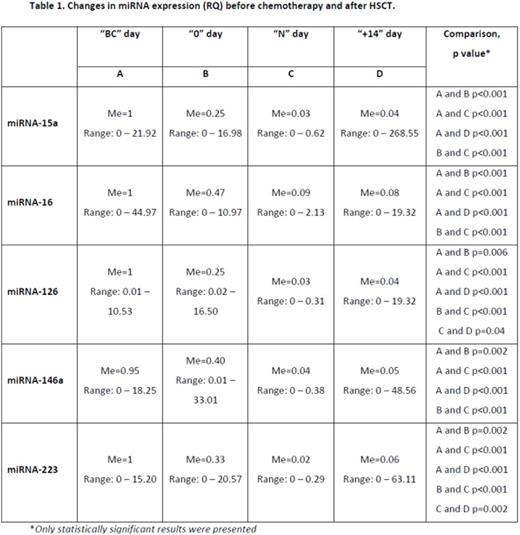Abstract
Introduction
MicroRNAs are a class of small (19-25 nucleotides), endogenous RNA which play a significant role in regulation of gene expressions, cell proliferation, differentiation, apoptosis. These class of small molecules, engaged in angiogenesis and hematopoiesis can influence hematopoietic stem cells (HSC) homing after transplantation by targeting bone marrow niche microenvironment. The aim of the study was to evaluate expression of miRNA-15a, miRNA-16 (engaged in angiogenesis, apoptosis, proliferation and differentiation of HSC) miRNA-126, miRNA-146a (regulating homing of HSC after transplantion) and miRNA-223 (involved in apoptosis and granulopoiesis) in patients with lymphoproliferative malignancies prior to autologous hematopoietic stem transplantation (HSCT) and in early posttransplant period.
Patients
Fifty one patients were enrolled to the study (23 F, 28 M). The median (Me) age was 59 years. The investigated group consisted of 42 multiple myeloma (7 CR, 27 VGPR, 8 PR), 7 non-Hodgkin lymphoma (3 CR, 4 PR), and 2 Hodgkin lymphoma (2 PR). The blood (plasma samples) were collected on 4 time points: before chemotherapy - "BC", on the day of HSCT (after chemotherapy) - "0", seven days after HSCT "N" (nadir) - "N" and fourteen days after HSCT - "+14".
Methods
Total RNA was isolated using miRNeasy Serum/Plasma KIT (Qiagen, Hilden, Germany). MiRNA conversion to cDNA was performed using TaqMan MicroRNA Reverse Transcription Kit (Applied Biosystems, Carlsbad, CA). We used TaqMan MicroRNA Assays (Applied Biosystems): has-miR-15a-5p, has-miR-15a-5p, has-miR-146a-5p, has-miR-126-3p and has-miR-223-3p primers) to detect mature miRNA. Reverse transcription conditions were normalized using 5 nmol mirVana miRNA Mimic (cel-miR-39) as an endogenous control (Ambion, Austin, TX). The miRNA level was evaluated by Real Time PCR method.
The Wilcoxon matched-pairs test was used to compare groups of dependent continuous variables: miRNA's RQ levels at two different time points. Spearman rank correlation coefficient (R) was used to compare independent variables: regeneration and miRNA's RQ level. Comparisons and correlations were considered significant if p<0.05.
Results
Kinetics of miRNA before conditioning treatment and after HSCT
Our research revealed significant, steady decline of miRNA-15a, miRNA-16, miRNA-126, miRNA-146a and miRNA-223 at all time points as compared to baseline (BC). We observed increased miRNA-126 and miRNA-223 expression on "+14" day as compared to "N" day (Tab. 1).
Correlation between miRNA expression and regeneration
We observed that higher level of investigated miRNAs after chemotherapy resulted in longer time to engraftment. Our research revealed positive correlation between miRNA-15a, miRNA-16, miRNA-126 and miRNA146a levels on "0' day and the time to engraftment (R=0.36, p=0.009), (R=0.41, p=0.003), (R=0.30, p=0.03), (R=0.29, p=0.03) respectively. Additionally we found positive correlation between levels of miRNA-15a, miRNA-146a and miRNA-223 assessed on "N" day and time of regeneration (R=0.33, p=0.02), (R=0.34, p=0.02) and (R=0.30, p=0.04) respectively. No correlation between expression of all investigated miRNAs before chemotherapy and time to engraftment was found.
Conclusions
In conclusion, all investigated miRNAs changed significantly after conditioning treatment. Low expression of miRNA-15a and miRNA-16, as HSC proliferation and angiogenesis factors, play important role in regeneration process after chemotherapy and in early post-transplant period.
Low expression of miRNA-223 on nadir day correlates with faster engraftment, which is probably related with miRNA-223 activity on different stages of hematopoietic cells development, especially myeloid precursors differentiation and maturation. Effective regeneration, correlated with decreased miRNA-126, miRNA-146a level after conditioning treatment, may be affected by well-known homing processes regulated by VCAM-1 and CXCR4/SDF-1 signaling. We suggest that investigated miRNAs expression in the early post-transplant period is significant for time to engraftment after HSCT.
Grzybowska-Izydorczyk:BMS: Honoraria; Novartis: Honoraria. Robak:AbbVie: Consultancy, Honoraria, Research Funding; Pharmacyclics, LLC, an AbbVie Company: Consultancy, Honoraria, Research Funding; Janssen: Consultancy, Honoraria, Research Funding.
Author notes
Asterisk with author names denotes non-ASH members.


This feature is available to Subscribers Only
Sign In or Create an Account Close Modal